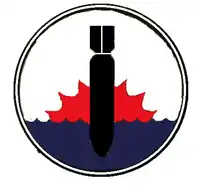424th Bombardment Squadron
The 424th Bombardment Squadron is an inactive United States Air Force unit. Its last assignment was with the 307th Bombardment Wing at Lincoln Air Force Base, Nebraska, where it was inactivated on 1 January 1962.
| 424th Bombardment Squadron | |
|---|---|
 B-47E Stratojet as flown by the 424th at Lincoln AFB | |
| Active | 1942–1945; 1953–1954; 1958–1962 |
| Country | |
| Branch | |
| Role | Bombardment |
| Part of | Strategic Air Command |
| Insignia | |
| 424th Bombardment Squadron emblem (approved 24 February 1943)[1] |  |
History

Formed as a heavy bombardment squadron in January 1942, trained in the Pacific Northwest under Second Air Force, with Boeing B-17 Flying Fortresses. Reassigned to Seventh Air Force in Hawaii, November 1942 and performed performing search and rescue and antisubmarine patrols until January 1943 while transitioning to long-range Consolidated B-24 Liberator heavy bombers.
Deployed to the Central Pacific from Hawaii throughout 1943 for long-range combat bombardment operations against Japanese forces in the Central Pacific; New Guinea; Northern Solomon Islands and Eastern Mandates campaigns. Deployed to the New Hebrides in Melanesia and operated from numerous temporary jungle airfields, engaging in long-range bombardment operations during the Bismarck Archipelago; Western Pacific; Leyte; Luzon and Southern Philippines campaigns until the end of the war in August 1945. Assigned to Clark Field, Philippines after the war ended, demobilized with personnel returning to the United States, unit inactivated as paper unit in January 1946 in California.
.jpg.webp)
During the Korean War, Tactical Air Command (TAC) trained aircrews at Langley Air Force Base, Virginia. The three squadrons of the 4400th Combat Crew Training Group performing this mission were Air National Guard (ANG) units that had been called up for the war. At the start of 1953, these squadrons were returned to state control and the 424d Bombardment Squadron took over the mission, personnel, and equipment of the 122d Bombardment Squadron of the Louisiana ANG.[3] In January 1954, the group mission shifted to tactical bombardment and it was redesignated the 4400th Bombardment Group. As the group began to anticipate the transition to Martin B-57 Canberra aircraft, TAC decided to replace the Table of Distribution 4400th group and its squadrons with the regular 345th Bombardment Group, which took over their mission in July 1954.[4]
The squadron was activated in 1958 at Lincoln Air Force Base, Nebraska. The squadron also began sending its aircraft to AMARC at Davis–Monthan in late 1961, and the squadron went non-operational. It was inactivated on 1 January 1962.
Lineage
- Constituted as the 35th Reconnaissance Squadron, (Heavy) on 28 January 1942
- Activated on 15 April 1942
- Redesignated 424th Bombardment Squadron (Heavy) on 22 April 1942
- Redesignated 424th Bombardment Squadron, Heavy in 1944
- Inactivated on 26 December 1945
- Redesignated 424th Bombardment Squadron, Light on 15 November 1952
- Activated on 1 January 1953
- Inactivated on 19 July 1954
- Redesignated 424th Bombardment Squadron, Medium on 11 August 1958
- Activated on 1 September 1958
- Discontinued and inactivated on 1 January 1962
Assignments
- 307th Bombardment Group, 15 April 1942 – 26 December 1945
- 4430th Air Base Wing (attached to 4400th Combat Crew Training Group), 1 January 1953
- 4400th Combat Crew Training Group (later Bombardment Group), 1 May 1953 – 19 July 1954
- 307th Bombardment Wing, 1 September 1958 – 1 January 1962.
Stations
|
|
Aircraft
- Boeing B-17 Flying Fortress, 1942
- Consolidated B-24 Liberator, 1942–1945
- Douglas B-26 Invader, 1953–1954
- Boeing B-47 Stratojet, 1958–1961.
See also
References
Notes
- Maurer, Combat Squadrons, pp. 520–521
- This aircraft flew 104 combat missions in the Pacific. Photo taken: 8 September 1944, Wakde Airfield, Netherlands East Indies
- See Mueller, p. 315
- See Maurer, Combat Units, pp. 225–226
Bibliography
![]() This article incorporates public domain material from the Air Force Historical Research Agency.
This article incorporates public domain material from the Air Force Historical Research Agency.
- Maurer, Maurer, ed. (1983) [1961]. Air Force Combat Units of World War II (PDF) (reprint ed.). Washington, DC: Office of Air Force History. ISBN 0-912799-02-1. LCCN 61060979.
- Maurer, Maurer, ed. (1982) [1969]. Combat Squadrons of the Air Force, World War II (PDF) (reprint ed.). Washington, DC: Office of Air Force History. ISBN 0-405-12194-6. LCCN 70605402. OCLC 72556.
- Mueller, Robert (1989). Air Force Bases, Vol. I, Active Air Force Bases Within the United States of America on 17 September 1982 (PDF). Washington, DC: Office of Air Force History. p. 315. ISBN 0-912799-53-6.